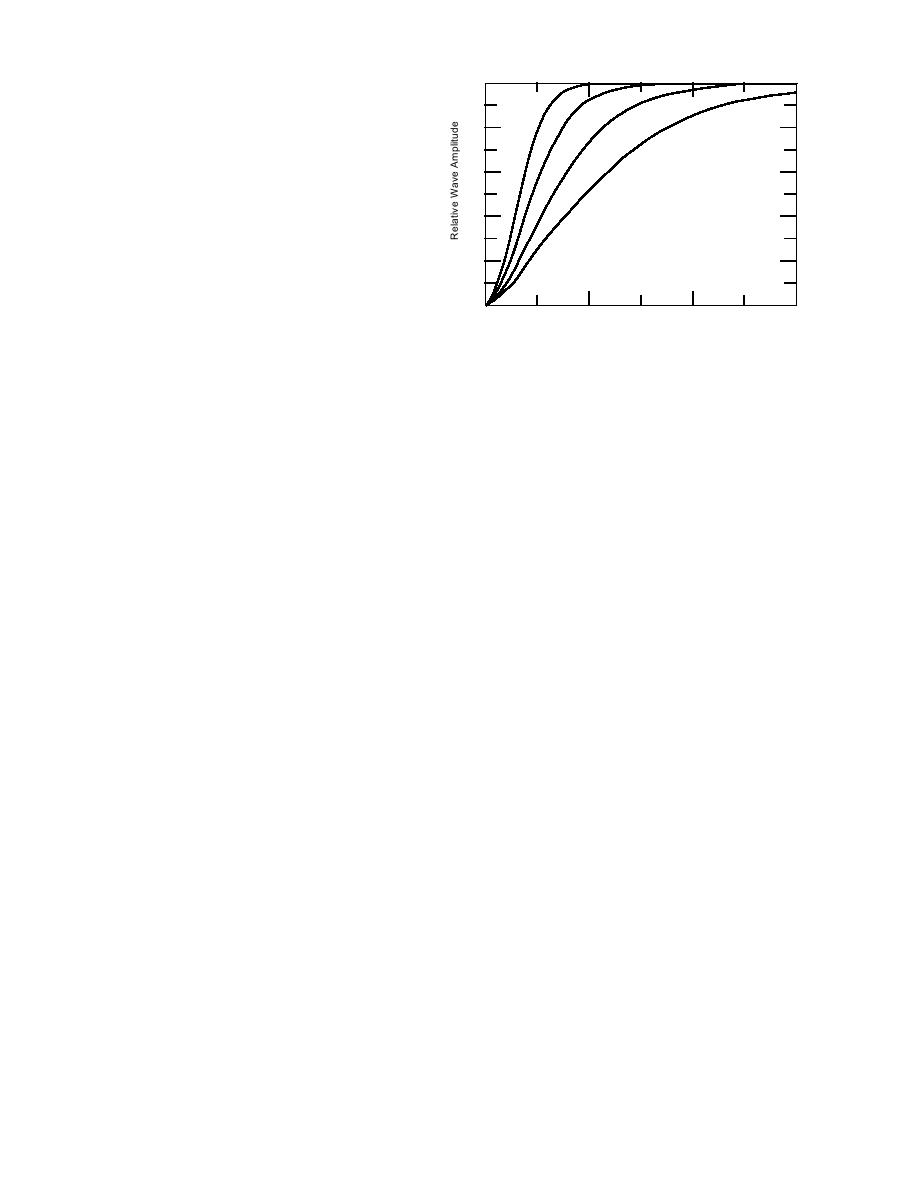
Wuebben et al. (1984) analyzed the variation
1.0
in ship-generated waves with vessel size on the
0.25
St. Marys, St. Clair and Detroit Rivers. For the
0.8
0.5
44 shoreline sites considered, the waves gener-
1.0
ated by a 1000-ft vessel traveling at existing speed
Ice Thickness, 2.0 m
limits were calculated to be no more than about
0.6
0.5 ft in amplitude at the shoreline. Although
equations are available for predicting ship-gen-
0.4
erated wave heights and their subsequent de-
cay in open water, none adequately address situ-
ations involving shallow water or confined or
0.2
irregularly shaped channels accompanied by
complex flow distributions such as those found
in the Great Lakes connecting channels. With-
0
10
20
30
out site-specific field data to calibrate and check
Wave Period (s)
the calculated values, any projections made must Figure 3. Damping of waves at an ice edge. The water
be considered approximate. The available theo- depth is 10 m. (From Carter et al. 1981.)
ries do, however, clearly show that vessel speed
is by far the most important variable control-
ling the magnitude of ship waves generated, fol-
ment transport or other effects due to prop wash,
lowed by the distance to the shoreline, which
and there were no data available for the Great
governs their decay.
LakesSt. Lawrence Seaway area. Most previous
During winter ice conditions, the short-period
studies of the damage potential of winter navi-
waves generated by vessel passage are effectively
gation were focused on shoreline and nearshore
damped by the ice cover. As part of a study of
effects. As a result, prop wash effects were typi-
the effects of winter navigation on shoreline ero-
cally disregarded since they are normally limited
sion and structure damage (USACE 1974), con-
to areas very close to the vessel track.
tinuous measurements of water level variations
In a study of the effect of vessel size on ship-
during ship passage were collected at several lo-
related damage, Wuebben (1983a) selected em-
cations on the St. Marys River during periods with
pirical relations based on their ability to deal with
and without an ice cover. These data clearly
the variation in propeller jet velocity for locations
showed both wind- and ship-generated waves
with limited depth or lateral confinement. Lack-
during open-water periods, but during periods
ing any calibration data from the Great Lakes sys-
with ice covers no waves were detectable.
tem, he was unable to provide site-specific, quan-
Figure 3 from Carter et al. (1981) shows the
titative predictions, but he did conclude that fully
effect of an ice cover on the height of waves en-
loaded commercial vessels are easily capable of
countering an ice cover. Relative wave amplitude
scouring the channel bed throughout the dredged
is defined as the height of a wave passing under
portions of the connecting channels. He also found
the ice divided by the height of that same wave
that vessel speed was by far the most important
under open-water conditions. Based on data given
factor determining the magnitude of prop wash,
in USACE (1974) and Ofuya (1970), the wave pe-
followed by cross-sectional area and hull geom-
riod for ships on the Great Lakes connecting chan-
etry. For confined channels, hydraulic interaction
nels is on the order of 24 s. Thus, according to
with the channel boundaries requires a higher
Figure 3, these ship-generated waves would be
propeller thrust to maintain open-water speed,
drastically attenuated during navigation in ice
increasing the damage potential.
relative to their open-water heights (a 3-ft, 3-s wave
Hochstein and Adams (1985b, 1986) modified
would be reduced to 0.3 ft by a 1.5-ft-thick ice
their existing prop wash numerical model for ap-
cover). Further, since these waves decay rapidly
plication to the St. Marys River by incorporating
(even in open water) as they propagate from the
appropriate ship and site characteristics and trans-
ship, these waves are considered to be insignifi-
ferring other necessary information from earlier
cant and will not be addressed further.
studies on the Kanawha and Ohio Rivers in West
Virginia and Ohio. They concluded that the ef-
Propeller wash
fects of prop wash could not be effectively sepa-
During vessel passage the bottom and sides
rated from backwater (drawdown) influences, so
of a channel may be subjected to a propeller-driven
water jet. There has been very little study of sedi-
they considered both simultaneously. Through a
4



 Previous Page
Previous Page
